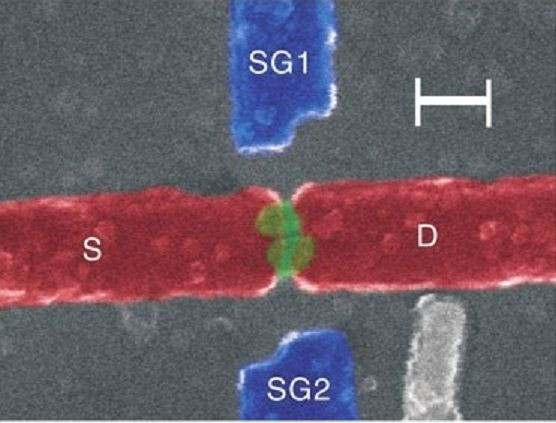Scientists Create Spin-Entangled Electrons, Step Toward Quantum Computing

A team of scientists has come up with a new way to harness light particles known as photons, exploiting quantum mechanics to vastly increase the amount of data in each particle.
The team led by researchers from the RIKEN Center for Emergent Matter Science in Japan demonstrated for the first time that quantum-entangled electrons maintain the same spin, even when they are separated from one another on a chip, paving the way for quantum information networks that would significantly improve computing power. The results of the research were published Wednesday in the journal Nature Communications.
"We set out to demonstrate that spin-entangled electrons could be reliably produced. So far, researchers have been successful in creating entangled photons, since photons are extremely stable and do not interact,” Russell Deacon, a RIKEN research scientist who led the experiment, said in a press release. “Electrons, by contrast, are profoundly affected by their environment. We chose to try to show that electrons can be entangled through their spin, a property that is relatively stable."
Entangled electron pairs that were located some distance from each other were theorized by scientists including Albert Einstein, Boris Podolsky and Nathan Rosen, but this has never been possible in practice until now.
To entangle the particles, the researchers built a tiny device just a few nanometers in size, which would allow them to get two electrons across a junction between two superconductor leads in order to pass them through two separate “quantum dots” -- crystals that are small enough to exhibit quantum properties. "If we could detect a superconducting current, this would mean that the electrons, which can be used as quantum bits -- the qubits, or bits used in quantum computing -- remain entangled even when they have been separated between the quantum dots,” Deacon said. “We confirm this separation by measuring a superconducting current that develops when they split and are recombined in the second lead."
The quantum dots were placed at random positions on a semiconductor chip. Pairs of dots that were close enough to be used for entangling were identified. "We observed thousands of dots and identified around a hundred that were suitable. From these we made around twenty devices. Of those just two worked," Deacon said.
By measuring the superconducting current across the two particles, the scientists showed that the electrons’ spin became entangled as they passed through the dots. "Since we have demonstrated that the electrons remain entangled even when separated, this means that we could now use a similar, albeit more complex, device to prepare entangled electron pairs to teleport qubit states across a chip," Deacon said.
The scientists said that the discovery could potentially lead to the development of applications such as quantum networks and quantum teleportation.
“Though it is technically difficult to handle, electron spin is a very promising property for these applications, as it is relatively free from the environment and lasts comparatively long. It could be combined with photons, by using the spin-entangled electrons to create photons that themselves would be entangled. This could allow us to create large networks to share quantum information in a widely distributed way," said Seigo Tarucha, head of RIKEN.
© Copyright IBTimes 2025. All rights reserved.





















